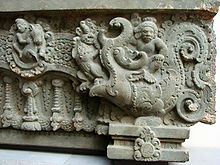Maruts
This article needs additional citations for verification. (December 2009) |
| Maruts | |
|---|---|
Gods of (Monsoon) Thunderstorms and the Vedic Männerbund | |
 The Maruts, preserved in Paris | |
| Abode | Midspace |
| Weapon | Lightning |
| Parents | |
| Consort | Rodasī |
In Hinduism, the Maruts (/məˈrʊts/;[2] Template:Lang-sa), also known as the Marutagana and sometimes identified with Rudras,[3] are storm deities and sons of Rudra and Prisni. The number of Maruts varies from 27 to sixty (three times sixty in RV 8.96.8). They are very violent and aggressive, described as armed with golden weapons i.e. lightning and thunderbolts, as having iron teeth and roaring like lions, as residing in the north, as riding in golden chariots drawn by ruddy horses.
In the Vedic mythology, the Maruts act as Indra's companions as a troop of young warriors.[4] According to French comparative mythologist Georges Dumézil, they are cognate to the Einherjar and the Wild hunt.
In mythology
Hymn 66 of Mandala VI of the Rig Veda, the ancient collection of sacred hymns, is an eloquent account of how a natural phenomenon of a rain-storm metamorphoses into storm deities.[5]
According to the Rig Veda they wore golden helmets and breastplates, and used their axes to split the clouds so that rain could fall. The clouds were capable of shaking mountains and destroying forests. Though they were the offspring of Rudra, they were adopted by Indra,[4] who was entitled as Marutvant ("Accompanied by the Maruts"). They are also accompanied by a female deity, Rodasi, who rides with them through the heavens.[6]
The Maruts help Indra defeat Vritra, lending him their power.[4] The myth continues with Indra disputing them their role on the battle, accusing them of having abandoned him after giving him encouragement before the fight, and they quarrel for the sacrifice given by the sage Agastya. However, their place to his side in mythology is accepted, appearing elsewhere with him.[6]
According to later tradition, such as Puranas,[7] the Maruts were born from the broken womb of the goddess Diti, after Indra hurled a thunderbolt at her to prevent her from giving birth to too powerful a son. The goddess had intended to remain pregnant for a century before giving birth to a son who would threaten Indra.
See also
References
- ^ Stephanie Jamison (2015). The Rigveda –– Earliest Religious Poetry of India. Oxford University Press. p. 49. ISBN 978-0190633394.
- ^ "Marut". Random House Webster's Unabridged Dictionary.
- ^ Max Müller. Vedic Hymns. Atlantic Publishers. p. 352.
- ^ a b c De Witt Griswold, Harvey (1923). The Religion of the Rigveda. Oxford University Press. ISBN 9780896843059.
{{cite book}}: Unknown parameter|pg=ignored (help) - ^ Max Müller, Hermann Oldenberg. Vedic Hymns: Part I. Library of Alexandria. p. 177.
- ^ a b Jamison, Stephanie W.; Brereton, Joel P. (2014). The Rigveda: The Earliest Religious Poetry of India, Volumen 1. Oxford University Press. ISBN 9780199370184.
{{cite book}}: Unknown parameter|pg=ignored (help) - ^ Tamra Andrews. Dictionary of Nature Myths: Legends of the Earth, Sea, and Sky. Oxford University Press. p. 116.
